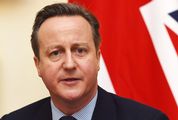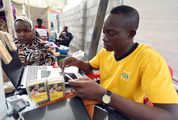DISNEY World’s MagicBand unlocks hotel rooms, schedules ride times, pays for meals, and activates queue-jumping "fast passes".
These hi-tech wristbands were introduced to the Florida theme park in 2013, and are embedded with a radio-frequency identification chip that does all of this, and more. They can be read from 40m away — so Disney staff armed with smartphones and an app greet you by name before you introduce yourself.
Disney Parks, which, according to security news website CSO Online, posted a 17% profit increase in 2013, uses the information gathered from the wristbands to track guests’ whereabouts, personal preferences, and spending patterns.
Despite detractors finding being tracked like this "creepy", there are upsides to this kind of wearable technology. MagicBand’s effectiveness led to Mark Rolston, who was CEO at design firm Frog when it developed it for Disney, designing a similar device for hospital use.
The idea is that issuing patients and doctors with the bands will allow better tracking throughout hospitals, trimming waiting times and conceivably even saving lives.
"Like at Disney, privacy issues come to mind," writes Mark Wilson for fastcodesign.com. "Patients might wonder, who on staff sees my medical records, and when? Nurses and doctors might balk at their employer tracking their movements all day at work (who wouldn’t)? And then there’s the biggest catch: sooner or later, someone is going to end up with the wrong band, and a hospital run largely by automation could ferry someone to the wrong treatment with fewer human checks and balances in place."
Wearable technology has helped UK-based supermarket Tesco increase efficiency. It was a first-mover, issuing warehouse staff at 300 locations across the UK with wearables in 2004.
Between 2007 and 2012 the number of full-time employees needed to run a 3,700m² store was reduced 18%, the Harvard Business Review reported.
While managers and shareholders were pleased, not all staff were. Some argued the technology measured only speed and not quality of work.
When offering this type of technology to white collar workers, things become more complicated. They boil down to what lawyer Brian Patterson, director of ENSafrica’s employment law division, terms: "If I can’t justify it, I can’t have it."
Even if employees consent to carrying devices issued by employers, Patterson says this is not enough. An employer also has to provide a policy that regulates reasonable use, ensure its use of whatever information is gathered is "not unnecessarily invasive", and explain how the information will be gathered and used.
There are also security concerns, especially when personal information — from physical location, to medical information such as heart rate and blood pressure — is collected, because it must be transmitted between device and database.
"Even if you have consent, your access is limited," Patterson says. "Doing so must be reasonable, proportional and there must be security safeguards. Consent is not unlimited."
An employer, for example, would not be legally able to monitor the movements of an employee’s smart device after office hours. (And this reveals a shortcoming — there are ways to cheat these devices, such as leaving a GPS-monitored smartphone at work while you are at play during working hours.)
There is also the issue of coercion — believing that not accepting and wearing the device will, at best, be regarded as not being a team player or, at worst, losing a job.
For South Africans there is not yet a lot of legal protection against an employer’s misuse of data collected from a wearable, says Patterson. That will soon change.
While there is little in the way of case law that sets precedents on employers’ privacy invasions, it is probable the Protection of Private Information Act (Popi) will come into force in the next 18 months, Patterson says.
The act was gazetted in November 2013, but has yet to come into full practical force. The signs, however, are there — parts of the act were brought into force in April 2014 and 2015 the government called for nominations for an information regulator. No appointment has yet been made.
South Africans, it appears, are fairly open to the idea of workplace wearables; more so than their UK counterparts.
A survey by PwC of 2,283 people, 51% between the ages of 25 and 34, said they would share with their employer data from wearable technology.
In the survey, released earlier this year, this percentage rose to 87% when it was suggested the data would be used to the employee’s benefit, such as introducing flexible working hours. For the UK these figures were 44% and 56% respectively.
"Providing employees with wearable devices could be a novel and powerful way for organisations to gain better understanding of their workforce and tailor working patterns and office life to their individual needs; ultimately leading to more engaged and happy employees," PwC concluded.
Trust, however, is the biggest barrier. PwC says 20% of respondents said they did not trust their employer to not use the information against them in some way, and another 20% said they did not trust their employer to use the data to their benefit.
PwC was primarily looking at the use of health-and work-related data such as exercise, blood pressure, commuting times and commuting distances.
More than two-thirds of respondents (72%) said they would be interested in receiving fitness incentives such as reduced-rate gym membership and lower health premiums (70%), but this dropped to 59% when free annual health checks were on offer, and 26% of the respondents said they did not want any of the benefits.
The top reason given (32%) was that they did not want to share this type of information.

Disney World’s MagicBand enables visitors to book rides in advance, pay for meals, unlock hotel rooms and manage queues. It also allows the park to gather information on spending habits and personal preferences. Picture: BLOOMBERG/MATT STROSHANE
DISNEY World’s MagicBand unlocks hotel rooms, schedules ride times, pays for meals, and activates queue-jumping "fast passes".
These hi-tech wristbands were introduced to the Florida theme park in 2013, and are embedded with a radio-frequency identification chip that does all of this, and more. They can be read from 40m away — so Disney staff armed with smartphones and an app greet you by name before you introduce yourself.
Disney Parks, which, according to security news website CSO Online, posted a 17% profit increase in 2013, uses the information gathered from the wristbands to track guests’ whereabouts, personal preferences, and spending patterns.
Despite detractors finding being tracked like this "creepy", there are upsides to this kind of wearable technology. MagicBand’s effectiveness led to Mark Rolston, who was CEO at design firm Frog when it developed it for Disney, designing a similar device for hospital use.
The idea is that issuing patients and doctors with the bands will allow better tracking throughout hospitals, trimming waiting times and conceivably even saving lives.
"Like at Disney, privacy issues come to mind," writes Mark Wilson for fastcodesign.com. "Patients might wonder, who on staff sees my medical records, and when? Nurses and doctors might balk at their employer tracking their movements all day at work (who wouldn’t)? And then there’s the biggest catch: sooner or later, someone is going to end up with the wrong band, and a hospital run largely by automation could ferry someone to the wrong treatment with fewer human checks and balances in place."
Wearable technology has helped UK-based supermarket Tesco increase efficiency. It was a first-mover, issuing warehouse staff at 300 locations across the UK with wearables in 2004.
Between 2007 and 2012 the number of full-time employees needed to run a 3,700m² store was reduced 18%, the Harvard Business Review reported.
While managers and shareholders were pleased, not all staff were. Some argued the technology measured only speed and not quality of work.
When offering this type of technology to white collar workers, things become more complicated. They boil down to what lawyer Brian Patterson, director of ENSafrica’s employment law division, terms: "If I can’t justify it, I can’t have it."
Even if employees consent to carrying devices issued by employers, Patterson says this is not enough. An employer also has to provide a policy that regulates reasonable use, ensure its use of whatever information is gathered is "not unnecessarily invasive", and explain how the information will be gathered and used.
There are also security concerns, especially when personal information — from physical location, to medical information such as heart rate and blood pressure — is collected, because it must be transmitted between device and database.
"Even if you have consent, your access is limited," Patterson says. "Doing so must be reasonable, proportional and there must be security safeguards. Consent is not unlimited."
An employer, for example, would not be legally able to monitor the movements of an employee’s smart device after office hours. (And this reveals a shortcoming — there are ways to cheat these devices, such as leaving a GPS-monitored smartphone at work while you are at play during working hours.)
There is also the issue of coercion — believing that not accepting and wearing the device will, at best, be regarded as not being a team player or, at worst, losing a job.
For South Africans there is not yet a lot of legal protection against an employer’s misuse of data collected from a wearable, says Patterson. That will soon change.
While there is little in the way of case law that sets precedents on employers’ privacy invasions, it is probable the Protection of Private Information Act (Popi) will come into force in the next 18 months, Patterson says.
The act was gazetted in November 2013, but has yet to come into full practical force. The signs, however, are there — parts of the act were brought into force in April 2014 and 2015 the government called for nominations for an information regulator. No appointment has yet been made.
South Africans, it appears, are fairly open to the idea of workplace wearables; more so than their UK counterparts.
A survey by PwC of 2,283 people, 51% between the ages of 25 and 34, said they would share with their employer data from wearable technology.
In the survey, released earlier this year, this percentage rose to 87% when it was suggested the data would be used to the employee’s benefit, such as introducing flexible working hours. For the UK these figures were 44% and 56% respectively.
"Providing employees with wearable devices could be a novel and powerful way for organisations to gain better understanding of their workforce and tailor working patterns and office life to their individual needs; ultimately leading to more engaged and happy employees," PwC concluded.
Trust, however, is the biggest barrier. PwC says 20% of respondents said they did not trust their employer to not use the information against them in some way, and another 20% said they did not trust their employer to use the data to their benefit.
PwC was primarily looking at the use of health-and work-related data such as exercise, blood pressure, commuting times and commuting distances.
More than two-thirds of respondents (72%) said they would be interested in receiving fitness incentives such as reduced-rate gym membership and lower health premiums (70%), but this dropped to 59% when free annual health checks were on offer, and 26% of the respondents said they did not want any of the benefits.
The top reason given (32%) was that they did not want to share this type of information.





















